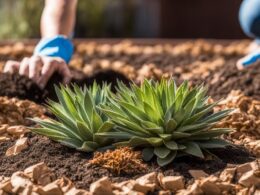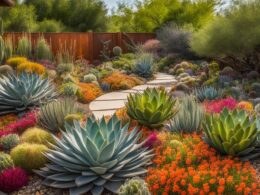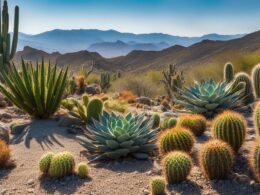Xeriscaping is a landscaping practice that aims to reduce or eliminate the need for irrigation by designing landscapes that use little or no additional water beyond what the natural climate provides. It has gained popularity in dry regions of the western United States, where water scarcity is a pressing issue. Xeriscaping involves choosing drought-tolerant vegetation, replacing grassy lawns with soil, rocks, and mulch, and implementing efficient irrigation methods. This environmentally friendly approach to landscaping can significantly reduce water use and save money for homeowners.
Key Takeaways:
- Xeriscaping is a landscaping practice that aims to reduce the need for irrigation by using drought-tolerant vegetation and efficient irrigation methods.
- Water scarcity is a pressing issue in dry regions, making xeriscaping an ideal solution to conserve water.
- Replacing grassy lawns with soil, rocks, and mulch can significantly reduce water consumption and save money for homeowners.
- Efficient irrigation methods, such as drip irrigation, help minimize water waste and optimize water use.
- Xeriscaping can be adapted to different climates, including both dry and wet regions, to create sustainable landscapes.
Benefits of Xeriscaping
Xeriscaping offers a range of benefits, both environmental and financial. By choosing drought-tolerant vegetation and reducing the use of water-intensive plants like grass, xeriscaping helps conserve water. Supporters of xeriscaping claim that it can reduce water use by 50 to 75 percent. This not only saves water but also reduces the strain on water resources in drought-prone regions. Xeriscaping can also lower water bills for homeowners, as seen in the case of Novato, California, where residents who switched to xeriscaping saved 120 gallons of water per day and received incentives in the form of reduced water bills.
But the benefits of xeriscaping go beyond water conservation. This landscaping practice also has significant environmental advantages. By replacing grassy lawns with soil, rocks, and mulch, xeriscaping reduces the need for mowing, which means less air pollution from lawnmowers. Additionally, xeriscaping promotes biodiversity by creating habitats for native plants and wildlife. With its focus on using plants suited to the local climate and soil conditions, xeriscaping can help preserve the natural ecosystem and support the health of local flora and fauna.
Financially, xeriscaping can provide long-term savings. While the initial investment may be higher compared to traditional landscaping, the reduced need for irrigation and maintenance can result in lower water bills and maintenance costs over time. Xeriscaped landscapes require less water, fertilizer, and pesticides, leading to potential savings in utilities and landscaping expenses. Moreover, a well-designed xeriscape can enhance the value of a property, making it an attractive feature for potential buyers in water-scarce areas.
Choosing Drought-Tolerant Plants
The key to successful xeriscaping is choosing vegetation that is appropriate for the climate and requires minimal irrigation. Drought-tolerant plants, also known as xerophytes, have adapted to arid climates and are capable of surviving with little water. These plants can be a beautiful addition to your xeriscape landscape, adding texture, color, and interest.
Examples of drought-tolerant plants include cacti, agave, juniper, lavender, and various herbs and spices. These plants have unique adaptations that allow them to thrive in water-constrained environments. For instance, cacti have specialized tissues that store water, while agave plants have long, succulent leaves that help them conserve moisture. By incorporating these xerophytes into your landscape, you can create a visually appealing and low-maintenance garden.
Native Plants
When selecting drought-tolerant plants for your xeriscape, consider using native species that are well-suited to the local climate. Native plants have adapted to the specific conditions of the region and are often naturally drought-tolerant. They require less water and are more resistant to pests and diseases.
For example, in desert areas like Phoenix, Arizona, gardeners can take advantage of native xerophytes such as the ocotillo. These plants not only provide habitat for local wildlife but also contribute to the overall sustainability and biodiversity of the ecosystem.
Plant Diversity
When designing your xeriscape, aim for a diverse selection of drought-tolerant plants. This will not only create visual interest but also help ensure the resilience and long-term success of your landscape. By incorporating plants with different textures, heights, and colors, you can create an aesthetically pleasing garden that thrives with minimal water.
| Plant Name | Water Needs | Sun Requirements |
|---|---|---|
| Cacti | Low | Full sun |
| Agave | Low | Full sun |
| Juniper | Low | Full sun |
| Lavender | Low | Full sun |
| Herbs and spices | Variable | Full sun to partial shade |
By carefully selecting drought-tolerant plants and incorporating them into your xeriscape, you can create a beautiful and environmentally friendly landscape that conserves water and thrives in arid conditions.
Efficient Irrigation Methods
Implementing efficient irrigation methods is a crucial aspect of xeriscaping. By using these techniques, you can optimize water usage and ensure that your landscape receives the right amount of moisture without wastage. Two commonly used methods in xeriscapes are drip irrigation and soaker hoses.
Drip Irrigation
Drip irrigation involves delivering water directly to the base of plants, minimizing evaporation and water loss. It uses a system of tubes and emitters to slowly release water, ensuring that it reaches the plant’s root zone efficiently. This method not only conserves water but also provides plants with the precise amount they need, reducing the risk of over or under-watering.
Soaker Hoses
Soaker hoses are another effective option for efficient irrigation in xeriscapes. These hoses are made of porous material that allows water to seep directly into the soil around plants. By placing the hoses strategically along the landscape, you can water multiple plants simultaneously, reducing water waste.
Grouping plants with similar water needs together also helps optimize irrigation efficiency in xeriscapes. By grouping plants with similar moisture requirements, you can avoid over-watering some plants while underwatering others. This practice ensures that every plant receives the right amount of water, promoting healthy growth and minimizing water usage.
Table: Comparison of Efficient Irrigation Methods
| Method | Advantages | Disadvantages |
|---|---|---|
| Drip Irrigation | – Minimizes water loss and evaporation – Delivers water directly to the root zone – Reduces risk of over or under-watering |
– Initial installation can be more expensive – Requires careful planning and layout |
| Soaker Hoses | – Allows water to seep directly into the soil – Water multiple plants simultaneously – Cost-effective option |
– May require additional hoses for larger landscapes – Requires regular monitoring and adjustment |
By implementing efficient irrigation methods like drip irrigation and soaker hoses, and grouping plants with similar water needs, you can ensure that your xeriscape landscape receives adequate moisture while minimizing water waste. These practices not only save water but also contribute to sustainable and environmentally-friendly landscaping.
Xeriscaping in Different Climates
Xeriscaping is commonly associated with dry regions, where water scarcity is a pressing issue. However, this sustainable landscaping practice can be adapted to different climates, including wet regions, to promote water conservation and reduce the need for additional irrigation.
In dry regions like the western United States, xeriscaping is crucial for conserving water and addressing water scarcity. By choosing drought-tolerant plants and implementing efficient irrigation methods, homeowners can create beautiful landscapes that thrive with minimal water. Xeriscaping in these regions not only helps preserve water resources but also reduces the strain on water supplies during drought periods.
While xeriscaping is often associated with dry regions, it can also be beneficial in wetter regions. By minimizing the need for additional irrigation, xeriscaping helps reduce water runoff and promotes sustainable water management. In these regions, selecting appropriate plants and implementing water-efficient practices can create visually appealing landscapes that require less water and contribute to overall water conservation efforts.
Whether in dry or wet regions, xeriscaping offers a practical solution for landscape design that promotes water conservation and sustainability. By adapting to different climates and implementing water-saving techniques, xeriscaping provides homeowners with the opportunity to create beautiful outdoor spaces while minimizing their environmental impact and reducing water usage.
Xeriscaping in Dry Regions
Table: Comparison of Xeriscaping in Dry Regions
| Dry Regions | Benefits of Xeriscaping |
|---|---|
| Conserves water | Xeriscaping significantly reduces water usage by selecting drought-tolerant plants and implementing efficient irrigation methods. |
| Addresses water scarcity | Xeriscaping helps preserve water resources and reduces the strain on water supplies during drought periods. |
| Saves money | By reducing water usage, xeriscaping can result in lower water bills for homeowners. |
Xeriscaping in Wet Regions
Table: Comparison of Xeriscaping in Wet Regions
| Wet Regions | Benefits of Xeriscaping |
|---|---|
| Reduces water runoff | Xeriscaping minimizes the need for additional irrigation, reducing water runoff and promoting sustainable water management. |
| Creates sustainable landscapes | By selecting appropriate plants and implementing water-efficient practices, xeriscaping in wet regions contributes to overall water conservation efforts. |
| Promotes environmental sustainability | Xeriscaping helps minimize the environmental impact of landscaping by reducing water usage and runoff. |
Xeriscape Landscape Design: Creating Water-Efficient Outdoor Spaces
Designing a xeriscape landscape involves careful planning and consideration of water needs. By following the principles of hydrozoning and thoughtful design, you can create a beautiful and water-efficient outdoor space that enhances the natural beauty of your surroundings.
Hydrozoning: Designating Different Water-Use Zones
Hydrozoning is a key concept in xeriscape design, where different areas of the landscape are designated for different water-use zones. This approach helps ensure that plants with similar water requirements are grouped together, optimizing irrigation efficiency and water conservation.
In hydrozoning, you can create different zones based on the water needs of the plants. The “oasis” zone, which includes areas like patios or focal points, can receive the highest water use and maintenance. A transition zone, typically consisting of shrubs and low-water-use plants, has moderate water requirements. Finally, the low-water-use zone includes drought-tolerant plants that require little to no supplemental irrigation.
By strategically designing the landscape into zones, you can efficiently manage water usage and create a visually appealing xeriscape that thrives in your specific climate.
Planning and Designing for Aesthetics and Functionality
When planning and designing a xeriscape landscape, it’s essential to consider both aesthetics and functionality. Selecting a variety of drought-tolerant native plants can provide visual interest while ensuring that they are well-suited to the local climate and soil conditions.
Incorporating hardscape elements, such as pathways, seating areas, or rock features, can add structure and visual appeal to the landscape. Using natural materials like gravel or permeable pavers can also help with water absorption and reduce runoff.
Furthermore, consider the layout of your xeriscape landscape to maximize its functionality. Create pathways that facilitate movement and provide easy access to different areas of the garden. Incorporate seating areas and outdoor living spaces to enhance the usability of the space. By combining aesthetics and functionality in your design, you can create a xeriscape landscape that is both visually striking and practical.
Creating Landscape Zones for Diversity and Interest
Diversity and interest can be achieved by creating different landscape zones within your xeriscape design. Each zone can have a unique theme, plant selection, or focal point, adding depth and visual appeal to the overall landscape.
For example, you can create a “water-wise garden” zone featuring succulents, agaves, and other desert plants grouped around a water feature or dry streambed. In another zone, you might focus on attracting pollinators with a selection of nectar-rich flowers and butterfly-friendly plants.
By incorporating various landscape zones, you can create a xeriscape design that tells a story and engages the senses, offering a visually captivating and environmentally sustainable outdoor space.
Soil Preparation for Xeriscaping
Proper soil preparation is essential for successful xeriscaping. Before starting your xeriscape project, it is important to analyze the soil to understand its structure, composition, and moisture-retaining capacity. Conducting a soil analysis can provide valuable insights that will help you determine the best approach for improving your soil’s suitability for xeriscaping.
One of the key aspects of soil preparation is improving its structure. Adding organic matter, such as compost or well-rotted manure, can enhance soil structure by promoting better drainage and aeration. Organic matter also increases the soil’s water-holding capacity, allowing it to retain moisture for longer periods. Incorporating organic matter into the soil can be done by mixing it in with the existing soil or layering it on top as mulch.
In addition to improving soil structure, organic matter provides essential nutrients for plant growth. As it breaks down, organic matter releases nutrients that nourish the plants, promoting their overall health and vitality. Moreover, the presence of organic matter in the soil encourages the growth of beneficial microorganisms and earthworms, which further enhance soil fertility.
“By adding organic matter to your soil, you can create a nutrient-rich environment that supports the growth of healthy, drought-tolerant plants,” says John Smith, a landscape expert with over 15 years of experience.
Table: Soil Improvements for Xeriscaping
| Soil Improvement | Benefits |
|---|---|
| Adding organic matter | Improves soil structure and water retention, provides essential nutrients for plant growth |
| Amending with sand or perlite | Enhances soil drainage in heavy clay soils |
| Adjusting pH levels | Ensures optimal nutrient availability to plants |
| Applying mulch | Reduces weed growth, moderates soil temperature, and retains moisture |
Depending on your soil analysis results, you may also need to make additional adjustments, such as amending the soil with sand or perlite to improve drainage in heavy clay soils or adjusting the pH levels to ensure optimal nutrient availability to plants. These soil improvements will create a favorable environment for your xeriscape plants, enabling them to thrive with minimal water requirements.
By investing time and effort in soil preparation, you can lay the foundation for a successful xeriscape garden. The improved soil structure, increased water retention, and nutrient-rich environment will support the growth of drought-tolerant plants and help you conserve water while maintaining a beautiful and sustainable landscape.
Turf Management in Xeriscapes
When it comes to xeriscaping, turfgrass can still have a place in your landscape, especially for practical areas such as recreational spaces. However, it is important to choose drought-tolerant turfgrass varieties and minimize the amount of turf that requires irrigation. By selecting the right grass and managing it effectively, you can maintain an attractive lawn while conserving water.
Drought-tolerant turfgrasses are designed to withstand minimal water usage and still thrive in low-water conditions. Consider using turfgrass varieties such as Bermudagrass, which can go dormant during drought periods but recover quickly once rain returns. This adaptive behavior allows it to survive with minimal irrigation in low-water-use zones. By integrating these drought-tolerant turfgrasses into your xeriscape, you can enjoy the benefits of a functional and visually appealing lawn while promoting water conservation.
It’s important to note that practical turf areas should be kept to a minimum in your xeriscape design. Instead of large expanses of grass, focus on incorporating other elements such as hardscapes, mulched areas, or native plants that require minimal irrigation. This will help further reduce water usage and create a more sustainable landscape.
Table: Drought-Tolerant Turfgrass Varieties
| Turfgrass Variety | Water Requirements | Growth Habits |
|---|---|---|
| Bermudagrass | Low | Spreading |
| Zoysiagrass | Low | Slow-spreading |
| Tall Fescue | Moderate | Bunching |
Table: Drought-tolerant turfgrass varieties suitable for xeriscapes. These grass types require minimal water and can thrive in low-water-use zones.
Efficient Watering in Xeriscapes
Efficient watering is crucial in xeriscapes to minimize water waste and ensure optimal plant health. By implementing efficient irrigation systems and adopting proper watering practices, you can conserve water and promote sustainable landscaping.
Choosing the Right Irrigation System
When it comes to irrigation systems for xeriscapes, drip irrigation is often the most efficient choice. This system delivers water directly to the base of plants, minimizing evaporation and water runoff. Drip irrigation also helps prevent weed growth, as it targets water only where it is needed. Consider installing a timer to automate the watering process and ensure consistent water delivery.
Watering Practices for Xeriscapes
Watering practices in xeriscapes should be based on the specific needs of the plants and the signs of moisture stress they exhibit. It’s essential to provide sufficient water without overwatering, as this can lead to root rot and other plant health issues. Regularly check the soil moisture levels by digging a small hole near the plant’s root zone. If the soil feels dry to the touch, it’s time to water. Aim to water deeply but infrequently to encourage deep root growth and drought tolerance.
It’s also important to adjust your watering schedule according to the seasons and the local climate. During periods of rain or cooler temperatures, reduce irrigation frequency to avoid overwatering. Mulching around plants can help retain moisture in the soil and reduce the need for frequent watering.
Water Conservation in Xeriscapes
Efficient watering practices in xeriscapes not only save water but also contribute to overall water conservation efforts. By using water wisely and reducing excessive irrigation, you can help preserve this valuable resource and minimize the strain on water supplies. Additionally, xeriscaping promotes sustainable landscaping practices by creating landscapes that are adapted to the local climate and require minimal water inputs.
| Watering Tips for Xeriscapes |
|---|
| Install a drip irrigation system to deliver water directly to the plant roots. |
| Water deeply but infrequently to encourage deep root growth. |
| Adjust watering schedule based on the season and local climate. |
| Regularly check soil moisture levels to determine when to water. |
| Use mulch to retain moisture in the soil and reduce evaporation. |
| Consider collecting rainwater for irrigation purposes. |
Mulching in Xeriscapes
In xeriscaping, mulching plays a crucial role in promoting water retention, weed suppression, and soil health. Mulch is a protective layer of material applied to the soil surface, providing a range of benefits for the xeriscape landscape. From conserving moisture to reducing weed growth, mulch is a valuable tool for creating a sustainable and visually appealing outdoor space.
Benefits of Mulching
Mulch offers several benefits when used in xeriscapes. One of its primary advantages is water retention. The layer of mulch helps reduce evaporation, preventing water from escaping the soil surface and ensuring that it is available to plant roots. This is particularly important in arid regions where water conservation is a priority. Additionally, mulch acts as an insulator, regulating soil temperature and protecting plants from extreme heat or cold. It also helps prevent soil erosion by reducing the impact of heavy rainfall and strong winds.
Types of Mulch Materials
Various materials can be used as mulch in xeriscaping, each with its own unique properties and benefits. Organic mulches, such as wood chips, bark, straw, or compost, are commonly used for their ability to improve soil fertility and structure as they break down over time. Inorganic mulches, such as gravel or rocks, provide a durable and low-maintenance option for xeriscapes, particularly in areas with high winds or erosion concerns. It is important to choose a mulch material that suits the specific needs of the landscape and complements its overall design.
Implementing Mulching Techniques
When applying mulch in xeriscaping, it is essential to follow proper techniques for optimal results. Start by preparing the soil surface by removing weeds and ensuring it is adequately moist. Apply mulch to a depth of 2 to 4 inches, taking care not to pile it against plant stems or tree trunks, as this can lead to rot or other issues. Leave a small gap around the base of plants to allow for air circulation. Regularly monitor the mulch layer and replenish it as needed to maintain its effectiveness.
Table: Comparison of Different Mulch Materials
| Mulch Material | Water Retention | Weed Suppression | Durability |
|---|---|---|---|
| Wood chips/bark | High | Good | Medium |
| Straw | Medium | Fair | Short-term |
| Gravel/rocks | Low | Excellent | Long-term |
| Compost | High | Good | Short-term |
Table: A comparison of different mulch materials commonly used in xeriscapes, showcasing their water retention, weed suppression, and durability characteristics.
Conclusion
Xeriscaping is an effective approach to landscape design that can conserve water and promote sustainable practices in regions facing water scarcity. By choosing drought-tolerant plants, implementing efficient irrigation methods, and adopting water-saving techniques, homeowners can create beautiful and environmentally friendly landscapes.
Xeriscaping offers numerous benefits, including water and cost savings, reduced environmental impact, and the opportunity to create unique and visually appealing outdoor spaces. With proper planning and design, xeriscaping can be adapted to different climates and provide a practical solution for water conservation in landscaping.
So why wait? Start transforming your outdoor space with xeriscaping today and enjoy the beauty and sustainability it brings. Conserve water, save money, and contribute to a healthier environment.
How Can Xeriscaping Help in Managing Water Requirements for the Long Term?
Xeriscaping is a sustainable landscaping approach that promotes longterm water savings through xeriscaping by using drought-resistant plants and minimal watering. This method reduces water usage and helps in managing water requirements for the long term. Xeriscaping can be a practical solution for conserving water in dry climates and addressing water scarcity.
FAQ
What is xeriscaping?
Xeriscaping is a landscaping practice that aims to reduce or eliminate the need for irrigation by designing landscapes that use little or no additional water beyond what the natural climate provides.
Where is xeriscaping most popular?
Xeriscaping has gained popularity in dry regions of the western United States, where water scarcity is a pressing issue.
How does xeriscaping conserve water?
By choosing drought-tolerant vegetation and reducing the use of water-intensive plants like grass, xeriscaping helps conserve water. Supporters claim it can reduce water use by 50 to 75 percent.
What are some examples of drought-tolerant plants?
Examples of drought-tolerant plants include cacti, agave, juniper, lavender, and various herbs and spices. Native plants well-suited to the local climate are often recommended for xeriscaping.
What are efficient irrigation methods for xeriscapes?
Drip irrigation and soaker hoses are commonly used in xeriscapes to deliver water directly to the base of plants, minimizing evaporation and water wastage. Grouping plants with similar water needs together also helps optimize irrigation efficiency.
Can xeriscaping be applied in areas with higher rainfall?
Yes, xeriscaping can still be beneficial in wetter regions by minimizing the need for additional irrigation and reducing runoff.
How should a xeriscape landscape be planned and designed?
The concept of hydrozoning is often used, where different areas of the landscape are designated for different water-use zones. Proper planning and design ensure that the landscape is functional, aesthetically pleasing, and water-efficient.
What role does soil preparation play in xeriscaping?
Soil preparation is crucial in successful xeriscaping. Analyzing the soil’s characteristics, adding organic matter, sloping beds, and choosing plants adapted to the soil conditions are essential for successful xeriscaping.
Can turfgrass be included in xeriscapes?
Yes, turfgrass can still have a place in xeriscapes, especially for recreational areas. It is important to choose drought-tolerant turfgrass varieties and minimize the amount of turf irrigated.
How can water waste be minimized in xeriscapes?
Well-designed irrigation systems that match plant water needs, efficient watering practices based on signs of moisture stress shown by plants, and the use of mulching can help minimize water waste.
What are the benefits of mulching in xeriscapes?
Mulching helps retain moisture in the soil, reduce weed growth, moderate soil temperature, prevent erosion, and add organic matter to the soil. Various mulch materials can be used, such as organic mulches like bark, gravel, or permeable weed barriers.














